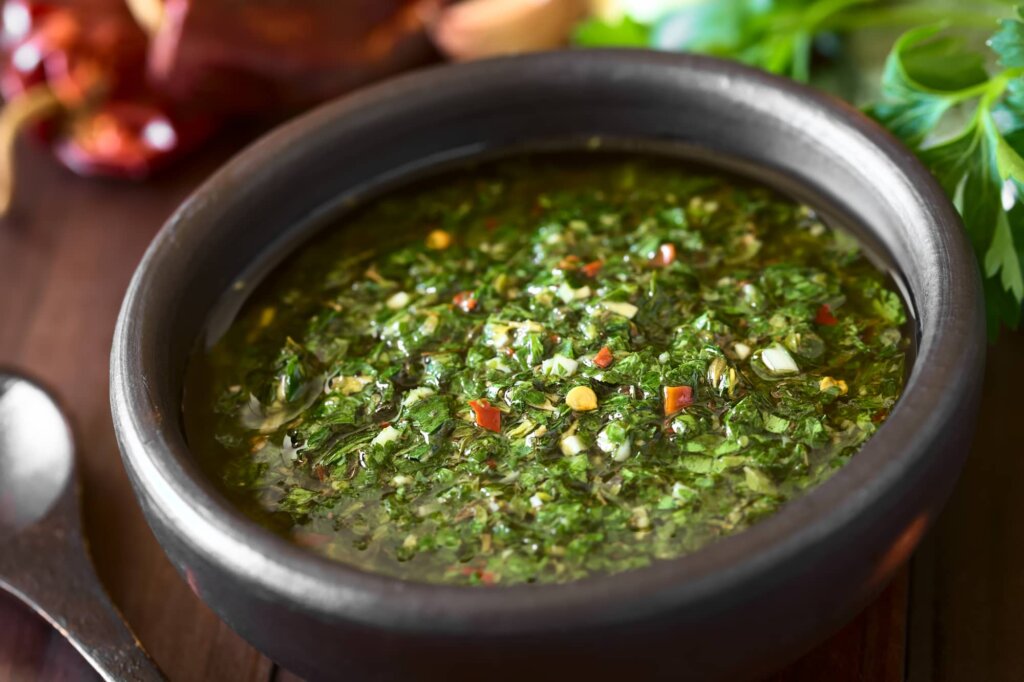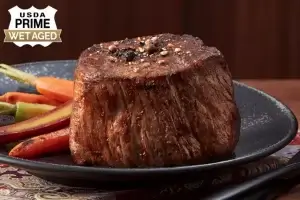
Chimichurri sauce is a bright, herbaceous condiment that hails from Argentina and Uruguay, where it is traditionally served with grilled meats. Its fresh and zesty flavor makes it a versatile addition to a wide range of dishes, from roasted vegetables to seafood. Here’s an in-depth look at this beloved sauce and how to make the most of it in your cooking.
What is Chimichurri?
Chimichurri is an uncooked sauce made with fresh herbs, garlic, vinegar, and olive oil. It’s known for its vibrant green color and bold flavor profile, which strikes a perfect balance between tangy, garlicky, and slightly spicy. Chimichurri comes in two varieties: green (chimichurri verde) and red (chimichurri rojo). While the green version is more common, the red variation includes paprika or red chili flakes for an added kick.
Chimichurri – Nutritional Facts
Per Tablespoon (Based on a 2,000-Calorie Daily Diet)
| Nutrient | Amount (% DV) |
|---|---|
| Calories | 85 |
| Total Fat | 9g (12%) |
| Saturated Fat | 1.3g (7%) |
| Cholesterol | 0mg (0%) |
| Sodium | 60mg (3%) |
| Total Carbohydrate | 1g (<1%) |
| Dietary Fiber | 0g (0%) |
| Sugars | 0g |
| Protein | 0g (0%) |
| Iron | 0.3mg (2%) |
| Vitamin C | 3mg (3%) |
| Calcium | 10mg (1%) |
| Potassium | 20mg (<1%) |
Why Chimichurri is So Popular
The appeal of chimichurri lies in its simplicity and adaptability. It requires minimal preparation yet delivers a burst of flavor that can elevate even the simplest of meals. It’s also a healthy alternative to creamy or sugary sauces, as it’s made primarily of fresh ingredients and heart-healthy olive oil.
How to Use Chimichurri Sauce
Chimichurri is traditionally served with grilled meats, particularly beef. However, its uses extend far beyond:
- Grilled Steak: Drizzle over a juicy ribeye or flank steak for a classic pairing.
- Roasted Vegetables: Toss roasted or grilled vegetables in chimichurri for a fresh twist.
- Seafood: Use it as a topping for grilled shrimp, salmon, or white fish.
- Poultry: Serve with roasted or grilled chicken for a zesty finish.
- Marinade: Use chimichurri as a marinade for meats or tofu before grilling.
- Sandwich Spread: Add a spoonful to sandwiches or wraps for an herbaceous kick.
Tips for Success
- Fresh Ingredients: Use the freshest herbs and garlic for the best flavor.
- Customizable Heat: Adjust the amount of red pepper flakes to suit your spice preference.
- Storage: Store chimichurri in an airtight container in the refrigerator for up to a week. Bring it to room temperature and stir before serving.
Conclusion
Chimichurri sauce is a celebration of fresh, bold flavors that can bring life to almost any dish. Whether you’re grilling steak, roasting vegetables, or looking for a flavorful marinade, this simple yet vibrant sauce is a must-try. Once you’ve tasted homemade chimichurri, you’ll understand why it’s a staple in South American cuisine and a favorite worldwide.

Chimichurri Sauce
Ingredients
- 1 cup fresh parsley washed, dried
- 5 medium cloves garlic peeled
- 2 tablespoons fresh oregano
- ½ cup extra-virgin olive oil
- ¼ cup red wine vinegar
- ¼ teaspoon red pepper flakes
- Sea salt to taste
Instructions
- Place parsley, garlic, and oregano in the work bowl of a food processor. Pulse until finely chopped, stopping to scrape down the sides of the bowl as necessary.
- Transfer to a medium bowl and whisk in oil, vinegar, salt, and red pepper flakes. Use immediately or store in the refrigerator for up to 2 days.


